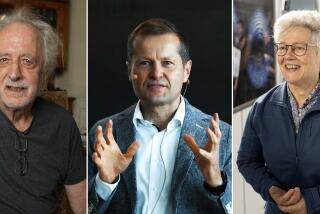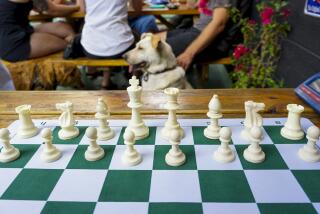Take that, A.I.: Video-gamers solve quantum physics mystery using human intuition
Computers may trounce humans at games like chess and Go, but there’s one game we’ve still got a lock on: quantum physics. Scientists who had people play an online video game that mimicked a troublesome quantum mechanical problem found that the gamers were far better than the computers at working out viable solutions.
The findings, published in the journal Nature, offer a surprisingly effective method of dealing with still-puzzling problems in quantum mechanics – and show that artificial intelligence may still have a lot to learn from the power of human intuition.
Scientists have been working to develop quantum computers, which takes advantage of the bizarre ways in which matter behaves at the tiniest of scales. Quantum computers have the potential to vastly outstrip the abilities of conventional devices, allowing them to perform a wide range of complex tasks, from cracking encrypted codes to operating self-driving cars.
But the very qualities that make quantum computing such an appealing way to store and process information also make its components exceedingly difficult to work with.
“If you’re not confused about quantum physics, that’s because you haven’t understood it,” said lead author Jacob Sherson, a quantum physicist at Aarhus University in Denmark, echoing a sentiment notably expressed by legendary Danish physicist Niels Bohr. “And that’s why no one thought you could think intuitively or rationally about quantum mechanical processes.”
Classical physics describes the physical world as we experience it at large scales (including the scales we humans operate in); quantum physics rules the world of tiny, particle-sized things, far beyond our perception. Quantum mechanics is built on uncertainties, and on rules that have no analogue in the day-to-day world in which we operate.
For example, according to Heisenberg’s uncertainty principle, you can’t perfectly know a particle’s position as well as its momentum at the same time. The more accurately you know its position, the more uncertain its momentum, and vice versa. Schrodinger’s famous feline thought-experiment illustrates how a given object can be in two mutually exclusive states at the same time: A possibly-poisoned cat in a box is both living and dead – until you open the box to observe it. (Of course, this isn’t actually the case with cat-sized things; this effect only works on exceedingly tiny scales.)
------------
For the record
April 14, 6:18 a.m.: In a previous version of this story, the uncertainty principle was explained as pertaining to the inability to accurately determine both a particle’s speed and momentum. The theory pertains to the inability to determine a particle’s position and momentum.
------------
For this paper, a team of Danish scientists was trying to deal with the pesky problem of moving atoms around without wrecking the information they contained. The scientists suspended them in “light crystals” and then would use optical tweezers to move them around. But there’s a problem: These atoms easily lose the information they carry.
“We had atoms in arrays like eggs in an egg tray, and we wanted to pick up atoms and move them around,” Sherson said. “But atoms, they are not really balls; they are more like waves. So as soon as you pick them up, they start to slosh and have motion, and it’s very hard to move these things fast.”
Sherson compared the problem to walking with a cup of coffee: If you walk slowly, it’s easy; but if you have to hurry, then it’s very hard to avoid spilling some of that liquid. The same goes for the particle-wave: The faster that atom is moved from one location to another, the more likely it is to lose precious information.
So why not just move those atoms at a more sedate pace? Because they can’t hold onto their information for long, and can drop it at the slightest disturbance. If the researchers move too slowly, their particles lose the information anyway.
So researchers have had to rely on powerful computers to try and find tactics allowing them to move the atom at that Goldilocks pace, neither too fast nor too slow. The problem is that computers really aren’t up to this complex task, Sherson said.
If you give a computer this job, it will try to find the answer by checking every single possible solution – a herculean task that it would never finish in time. Humans, on the other hand, have a real knack for forgetting, or filtering, information – tossing out irrelevant bits and focusing on the parts that might really matter.
The researchers turned to a fount that many scientists have dipped into in recent years: citizen science, pulling on the collective efforts of lay folk to tackle a given problem. Galaxy Zoo asks people to help classify large numbers of galaxies, and video games such as “Foldit” have been used to help researchers study protein folding.
“One can do things in games that cannot be done in reality, so gamers are used to experimenting with possibilities that go beyond the classical laws of physics,” Sabrina Maniscalco of the University of Turku in Finland, who was not involved in the study, wrote in a commentary. “Perhaps this ability to think outside the box allows them to make the creative leap necessary to tackle quantum problems.”
The researchers designed a game platform called Quantum Moves. In one of the games, called “BringHomeWater,” players are asked to transport a moving, water-like wave to a target area as fast as possible without spilling it. It’s pretty much the same thing that the scientists are trying to do in the lab -- except the players are about 100,000 times slower, Sherson said.
They found that the players developed solutions that were far more effective than their computer could -- and they did so at speeds that, according to the reseachers’ computer simulation, they’d thought impossible.

Their solutions drew upon what Sherson called a “perfect mixture” of classical mechanics as well as quantum mechanics – even though they’re two very different ways of describing the world. On the classical side: Accelerating an object down a steep slope will get it to move faster. On the quantum side: If a particle knocks at a barrier enough times, it can eventually appear on the other side – a phenomenon known as “tunneling.”
“The players somehow have some sort of intuition for this research problem that we didn’t imagine you could use intuition for,” Sherson said. “But placing it in this context of a game enabled humans to sort of look through the complexities of all that quantum-shmantum that we talk about.”
The researchers are continuing to use the human-generated solutions to improve the methods that could help make quantum computing a commercial reality one day. And they expect that different games can help scientists better understand a host of different quantum-mechanical quandaries.
“Whether [the authors’] method will be applicable to a wide range of problems in quantum physics is currently an open question,” Maniscalco wrote. “But because we are on the verge of a new era of quantum technologies, this approach is definitely worth pursuing.”
The findings, Sherson added, also raise questions about human intuition – how it does what it does and whether it’s possible to replicate it in artificial intelligence.
“What I think is we are inherently survivors. ... Survival and adaptation are just built into our being,” Sherson said. “In this ever-changing world, we will always adapt to it.”
Follow @aminawrite on Twitter for more science news and “like” Los Angeles Times Science & Health on Facebook.







